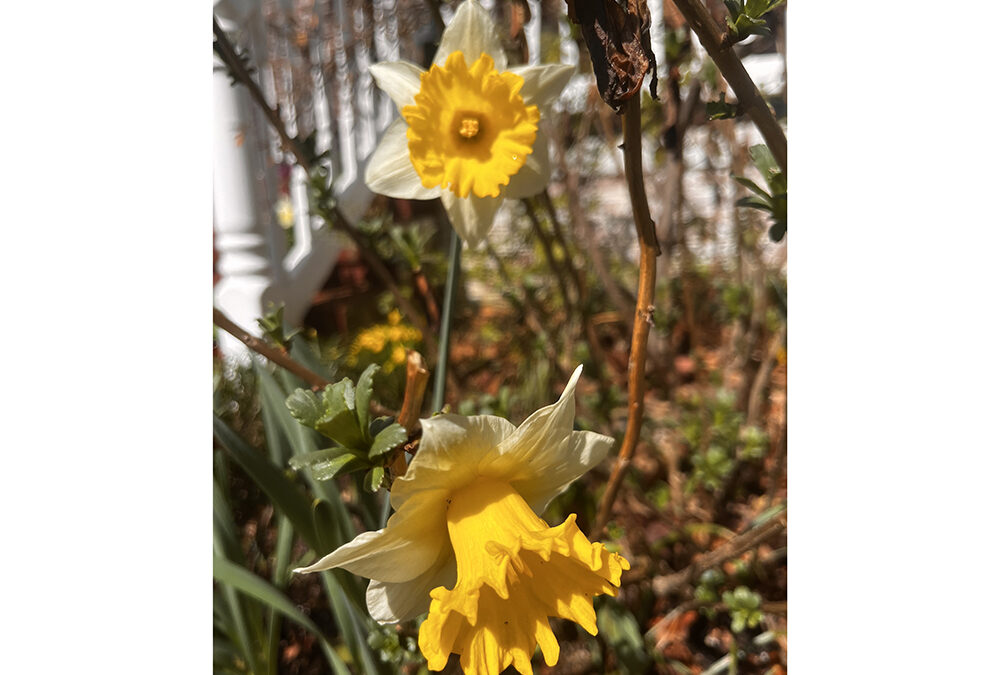Let It Grow
By Tammy Thornton
Congratulations, if you are reading this, you have safely made it to spring! In South Jersey, especially near the coast, the signs are all around us. The birds are singing more sweetly, trees are in bud, and daffodils, unable to contain their enthusiasm any longer, have been blooming brightly.
As harbingers of spring, daffodils know that longer days are here to stay. Of course, this time of year is unpredictable, weather-wise. But daffodils have no fear of frost and laugh at the cold. In fact, like other spring-blooming bulbs, daffodils need a period of cold dormancy in order to produce healthy flowers. To grow daffodils in warm climates, you would need to artificially imitate a cold period. We can remember how “lucky” we are when temperatures dip again.
Daffodils are easy to grow and are relatively pest- and disease-free. Simply pop the bulbs in the ground in the fall in well-drained soil, and wait until spring for your reward. If you missed planting bulbs in the fall, you can buy blooming plants now and plant them directly in your garden. Over time, daffodils will multiply and can be divided every three to five years. After your daffodils have finished blooming, resist the temptation to cut away unsightly leaves. While the leaves are green, they are helping the bulbs store energy for next year’s blooms. You can plant something in front of the daffodils if the look of the floppy leaves is bothering you. In late spring or early summer, the leaves will first turn yellow, then brown. At this point, you can divide the bulbs, if necessary, and remove the foliage.
Displaying cut daffodils in your home is a cheery way to bring spring indoors, but did you know that daffodils do not play well with others? Cut daffodils will emit a sap that is toxic to other flowers in a vase. To remedy this, you only need to give daffodils a “time-out” by themselves to remove the sap. After giving a fresh cut to the stems, place your daffodils in their own vase of water for three to six hours. Then, rinse out the vase, add fresh water, and proceed to make an arrangement with other types of flowers. If you recut the stems at any point, you will want to repeat this step. Keep in mind that this toxic chemical, called lycorine, makes daffodils toxic to pets and humans as well. All parts of daffodils are toxic, but the bulb contains the highest concentration of toxicity. Now, here’s the good news: This same chemical will also make daffodils distasteful to deer, rabbits, and squirrels. If you have trouble growing tulips or other spring-blooming plants because critters are always getting to them, plant daffodils around them as a wall of protection. Like walking around with your big brother, this may or may not work, but it will make deer, rabbit, and squirrel bullies consider picking on someone else.
While we typically think of yellow daffodils, they can come in a variety of shapes and colors. You can find daffodils with yellow, pink, or orange centers. There are also ones with white petals and even double-petal varieties. Some of my favorite daffodils are all white or all cream. These blend beautifully with grape hyacinths as well as all different shades of tulips. When you plant daffodils, be sure to plant them in groups of at least three to five bulbs for the most dramatic impact. When you walk by your garden, the scent will waft through the air and remind you that better days are ahead.
We would love to hear from our readers. Send your gardening questions and comments to: shorelocalgardener@gmail.com.
Tammy Thornton lives with her husband, children, and crazy pets while enjoying a life of gardening, cooking, and going to the beach.
















